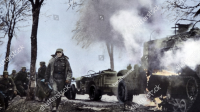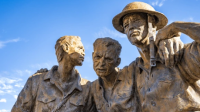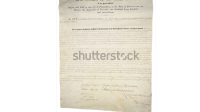Introduction: The Origins of a Lesser-Known but Significant War
The War of 1812, often overshadowed by other major conflicts in history, was a pivotal event that shaped the future of North America. Fought between the United States and the British Empire, including its colonies in Canada, the war began in June 1812 and lasted until February 1815. The conflict was fueled by a complex mix of political, economic, and territorial disputes, as well as issues related to national honor and sovereignty. While the war ended in a stalemate, it had profound and lasting effects on the young United States, Canada, and the British Empire.
The War of 1812 is sometimes referred to as the “Second War of Independence” because it was seen by many Americans as a continuation of the struggle to assert their sovereignty against British interference. For the British, the war was a distraction from their larger conflict with Napoleon in Europe, but it also became a critical theater for protecting their North American colonies. For Canadians, the war was a defining moment in the development of their national identity, as they successfully repelled American invasions and preserved their British ties.
Read Also : Treaty of Paris (1763): Redrawing the Map of the World
The Causes of the War: A Complex Web of Grievances
The War of 1812 was the result of a combination of factors, including maritime disputes, territorial ambitions, and issues of national honor. The conflict was not inevitable, but a series of escalating tensions and confrontations eventually led to the outbreak of war.
Maritime Disputes: Impressment and Blockades
One of the primary causes of the War of 1812 was the issue of maritime rights and the practice of impressment. During the Napoleonic Wars, the British Royal Navy, in desperate need of sailors, frequently boarded American ships to seize sailors who were British subjects or who could be claimed as such. This practice, known as impressment, outraged many Americans, who saw it as a violation of their national sovereignty and an affront to their honor.
In addition to impressment, the British imposed a series of naval blockades on France and its allies, which severely restricted American trade with Europe. The United States, a neutral nation, found its ships caught between the conflicting interests of Britain and France. The British Orders in Council, which restricted American trade with France, were particularly resented by American merchants, who saw them as an infringement on their right to trade freely.
The combination of impressment and trade restrictions led to widespread anger in the United States, particularly in the coastal regions where shipping and trade were vital to the economy. The U.S. government, under President James Madison, sought to resolve these issues through diplomacy, but when these efforts failed, the call for war grew louder.
Territorial Ambitions and Frontier Tensions
Another significant cause of the War of 1812 was the American desire for territorial expansion, particularly into British-controlled Canada and Spanish-held Florida. Many Americans, especially those on the western frontier, believed that Britain was supporting Indigenous resistance to American expansion in the Northwest Territory. British agents were accused of supplying arms and encouraging Indigenous leaders like Tecumseh to resist American encroachment on their lands.
The frontier tensions were exacerbated by a series of skirmishes and conflicts between American settlers and Indigenous nations, who were determined to defend their territories. The Battle of Tippecanoe in 1811, where U.S. forces led by General William Henry Harrison defeated a confederation of Indigenous warriors, further inflamed the situation. Many Americans saw the British as the instigators of these conflicts and believed that by defeating Britain, they could remove the Indigenous threat and open up new lands for settlement.
The expansionist sentiment was particularly strong among a group of young, nationalist politicians known as the “War Hawks,” who were elected to Congress in 1810. Led by figures like Henry Clay and John C. Calhoun, the War Hawks pushed for a more aggressive stance against Britain, believing that the conquest of Canada would be both easy and beneficial to the United States.
National Honor and Sovereignty
The War of 1812 was also driven by issues of national honor and the desire to assert American sovereignty on the global stage. The United States, still a relatively young nation, was eager to prove its independence and strength. Many Americans felt that Britain was treating them as a subordinate power, violating their rights and undermining their sovereignty.
The repeated insults to American honor, particularly the practice of impressment and the restrictions on trade, led to a growing sense of anger and frustration. The War Hawks and other advocates for war argued that military action was necessary to defend the nation’s honor and secure its place in the world.
By 1812, the combination of these factors—maritime disputes, territorial ambitions, and the desire for national respect—had created a powerful momentum for war. Despite the fact that the United States was militarily and economically unprepared for a major conflict, President Madison, under pressure from Congress and the public, asked for a declaration of war against Britain in June 1812. Congress approved the declaration, and the War of 1812 began.
The Early Stages of the War: Initial Setbacks and Challenges
The War of 1812 began with high hopes and expectations on both sides, but the early stages of the conflict were marked by a series of setbacks and challenges, particularly for the United States.
The Invasion of Canada: A Failed Ambition
One of the primary objectives of the United States at the outset of the war was the conquest of Canada. Many Americans believed that Canada would be easy to take, and that the local population, largely composed of recent immigrants from the United States, would welcome the American forces as liberators. However, these assumptions proved to be disastrously mistaken.
The U.S. military was ill-prepared for the invasion of Canada. The regular army was small, poorly trained, and inadequately equipped, while the militia forces, who made up the bulk of the American army, were often undisciplined and reluctant to fight outside their home states. Additionally, the American leadership was divided and inexperienced, leading to a series of poorly coordinated and executed campaigns.
The first major American offensive, led by General William Hull, aimed to capture the British fort at Amherstburg and secure control of the western Great Lakes. However, Hull’s campaign ended in failure when he was forced to surrender Detroit to a smaller British and Indigenous force in August 1812. This defeat was a severe blow to American morale and exposed the weaknesses in the U.S. military.
Subsequent attempts to invade Canada in 1812 and 1813 met with similar failures. The American forces were repeatedly repelled by British regulars, Canadian militia, and their Indigenous allies. The U.S. campaigns were hampered by logistical difficulties, lack of coordination, and strong resistance from the defenders. The anticipated easy victory in Canada turned into a protracted and frustrating struggle, with little to show for the American efforts.
Naval Warfare: Contesting Control of the Great Lakes
While the land campaigns in Canada were faltering, the War of 1812 also featured significant naval battles, particularly on the Great Lakes. Control of these inland waterways was crucial for both the British and American war efforts, as they served as vital supply routes and provided strategic access to the interior regions.
The U.S. Navy, though much smaller than the Royal Navy, achieved some notable successes in the early stages of the war. American warships, such as the USS Constitution, earned the nickname “Old Ironsides” for their victories over British vessels in the Atlantic. These naval victories provided a much-needed boost to American morale and demonstrated that the United States could challenge British naval supremacy.
However, the most critical naval battles of the war took place on the Great Lakes. In 1813, the Americans, under the command of Commodore Oliver Hazard Perry, won a decisive victory at the Battle of Lake Erie. Perry’s triumph secured American control of the lake and allowed for the successful recapture of Detroit later that year. This victory was one of the few clear successes for the U.S. in the early years of the war and had a significant impact on the course of the conflict in the western theater.
The British, for their part, maintained control of Lake Ontario and Lake Champlain for much of the war, enabling them to launch raids into American territory and support their forces in Canada. The naval contest on the Great Lakes was a critical aspect of the war, as it influenced the outcome of the land campaigns and the broader strategic balance between the two sides.
The Turning Points: Key Battles and Events in the War of 1812
As the war progressed, several key battles and events began to shift the momentum in favor of one side or the other. These turning points, while not always decisive, played a crucial role in shaping the final outcome of the conflict.
The Battle of Thames: Tecumseh’s Death and the Decline of Indigenous Resistance
One of the most significant turning points in the War of 1812 was the Battle of the Thames, fought on October 5, 1813, in present-day Ontario. The battle was a pivotal moment in the struggle for control of the western frontier and had far-reaching consequences for the Indigenous nations who had allied with the British.
The American forces, led by General William Henry Harrison, pursued the British and their Indigenous allies, led by the Shawnee leader Tecumseh, after their retreat from Detroit. The two sides clashed near the Thames River, where the Americans won a decisive victory. During the battle, Tecumseh was killed, dealing a severe blow to the Indigenous resistance movement.
Tecumseh’s death marked the beginning of the decline of the Indigenous confederation that had opposed American expansion into the Northwest Territory. Without Tecumseh’s leadership, the alliance began to fragment, and many Indigenous nations were forced to seek peace with the United States. The Battle of the Thames effectively ended British and Indigenous resistance in the western theater, allowing the United States to consolidate its control over the region.
The Burning of Washington: A Symbolic British Victory
In the summer of 1814, the British launched a major offensive against the United States, taking advantage of their success in Europe following the defeat of Napoleon. One of the most dramatic events of this campaign was the British attack on Washington, D.C., in August 1814.
A British force, led by Major General Robert Ross, marched into Washington after defeating American defenders at the Battle of Bladensburg. The British troops proceeded to burn several key government buildings, including the White House and the Capitol. The burning of Washington was a humiliating blow to the United States and a stark reminder of the vulnerability of the young nation.
While the burning of Washington was a symbolic victory for the British, it did not have a decisive impact on the outcome of the war. The British, facing logistical challenges and resistance from American forces, chose not to occupy the city and soon withdrew. Nevertheless, the event left a lasting mark on American memory and underscored the need for stronger national defense.
The Battle of Baltimore: The Birth of a National Anthem
Following the attack on Washington, the British turned their attention to the strategically important city of Baltimore. The British navy launched a bombardment of Fort McHenry, which guarded the entrance to Baltimore harbor, on September 13-14, 1814. The American defenders, under the command of Major George Armistead, withstood the intense bombardment, and the British were ultimately forced to withdraw.
The defense of Fort McHenry became a symbol of American resilience and determination. It was during this battle that Francis Scott Key, a lawyer and amateur poet, witnessed the bombardment and was inspired to write the poem “The Star-Spangled Banner.” The poem, set to the tune of a popular British song, later became the national anthem of the United States.
The successful defense of Baltimore, along with the American victory at the Battle of Plattsburgh on Lake Champlain, marked a turning point in the war. These successes helped to restore American morale and demonstrated that the United States could defend its territory against British attacks.
The Conclusion of the War: The Treaty of Ghent and Its Aftermath
As the war dragged on, both sides began to seek a way out of the conflict. The war had become increasingly unpopular in both Britain and the United States, and there was a growing recognition that neither side was likely to achieve a decisive victory.
The Treaty of Ghent: A Return to the Status Quo
Negotiations to end the war began in the summer of 1814 in the neutral city of Ghent, in modern-day Belgium. The American and British delegations, after several months of discussions, reached an agreement in December 1814. The Treaty of Ghent, signed on December 24, 1814, effectively ended the War of 1812.
The treaty was largely a return to the status quo ante bellum, meaning that both sides agreed to restore the territorial boundaries that existed before the war. No significant territory changed hands, and many of the issues that had caused the war, such as impressment and maritime rights, were left unresolved. However, the treaty did call for the cessation of hostilities and the return of prisoners, and it established commissions to settle boundary disputes between the United States and British North America.
The Treaty of Ghent was ratified by the British government in early January 1815 and by the U.S. Senate on February 17, 1815. News of the treaty took several weeks to reach North America, and during that time, one of the war’s most famous battles took place.
The Battle of New Orleans: A Final, Unnecessary Clash
One of the most well-known and ironic events of the War of 1812 was the Battle of New Orleans, fought on January 8, 1815, after the Treaty of Ghent had been signed but before news of the treaty had reached the combatants.
The British, seeking to capture the strategically important port of New Orleans, launched an attack on the city. The American forces, led by General Andrew Jackson, successfully defended the city, inflicting heavy casualties on the British. The victory at New Orleans made Jackson a national hero and became a source of pride for Americans.
The Battle of New Orleans, while a significant military victory for the United States, had no impact on the outcome of the war, as the peace treaty had already been signed. However, it reinforced the perception that the United States had emerged victorious and helped to bolster American nationalism in the post-war period.
The Legacy of the War of 1812: Nationalism and Identity
The War of 1812 had a lasting impact on the United States, Canada, and Britain, shaping the national identities and future development of all three nations.
The United States: A New Sense of Nationalism
In the United States, the War of 1812 is often remembered as a “second war of independence” that confirmed the nation’s sovereignty and solidified its place on the world stage. Despite the many setbacks and challenges during the war, the successful defense of key cities like Baltimore and New Orleans, along with the naval victories on the Great Lakes, fostered a sense of national pride and unity.
The war also had significant political consequences, leading to the decline of the Federalist Party, which had opposed the war and was seen as unpatriotic in its aftermath. The so-called “Era of Good Feelings” that followed the war was characterized by a spirit of nationalism and political consensus, as the United States entered a period of expansion and economic growth.
Canada: A Defining Moment in National Identity
For Canadians, the War of 1812 was a defining moment in the development of their national identity. The successful defense of British North America against American invasions reinforced the loyalty of Canadians to the British Crown and helped to foster a distinct sense of Canadian identity separate from the United States.
The war also highlighted the contributions of Indigenous allies in the defense of Canada, although their role and sacrifices were often overlooked in later years. The War of 1812 remains an important part of Canadian history, remembered as a struggle for survival and sovereignty.
Britain: A Minor Theater in a Global Conflict
For Britain, the War of 1812 was a relatively minor theater in the context of the larger Napoleonic Wars. The British government was primarily focused on the struggle against Napoleon in Europe, and the conflict with the United States was seen as a distraction. However, the war did reinforce the importance of the British navy and the need to protect its North American colonies.
The Treaty of Ghent allowed Britain to focus on rebuilding and consolidating its empire in the post-Napoleonic era. The war also underscored the complexity of British relations with its colonies and the United States, as well as the challenges of managing a global empire.
Conclusion: Reflecting on the War of 1812
The War of 1812 was a complex and multifaceted conflict that had significant implications for the future of North America. While the war ended in a stalemate, with no clear winner, it played a crucial role in shaping the national identities of the United States and Canada, as well as in reinforcing British imperial power.
The legacy of the War of 1812 continues to be felt today, as the events of the conflict are remembered and commemorated in both the United States and Canada. The war also serves as a reminder of the challenges of maintaining peace and resolving conflicts between nations, particularly in a world where national sovereignty and honor are at stake.
FAQ About the War of 1812
What caused the War of 1812?
The War of 1812 was caused by a combination of factors, including maritime disputes (such as impressment and trade restrictions), territorial ambitions (particularly the American desire to expand into Canada), and issues of national honor and sovereignty.
What were the key battles of the War of 1812?
Some of the key battles of the War of 1812 include the Battle of Lake Erie, the Battle of the Thames, the burning of Washington, the Battle of Baltimore, and the Battle of New Orleans.
What was the outcome of the War of 1812?
The War of 1812 ended in a stalemate with the signing of the Treaty of Ghent in 1814, which restored the territorial boundaries to their pre-war status. The war had significant political, social, and cultural impacts, particularly in the United States and Canada.
How did the War of 1812 affect the United States?
The War of 1812 fostered a sense of national pride and unity in the United States, solidifying the nation’s sovereignty and contributing to the decline of the Federalist Party. It also marked the beginning of a period of expansion and economic growth.
How is the War of 1812 remembered in Canada?
The War of 1812 is remembered in Canada as a defining moment in the development of Canadian identity. The successful defense of Canada against American invasions reinforced loyalty to the British Crown and helped to shape a distinct Canadian national consciousness.







1 comment